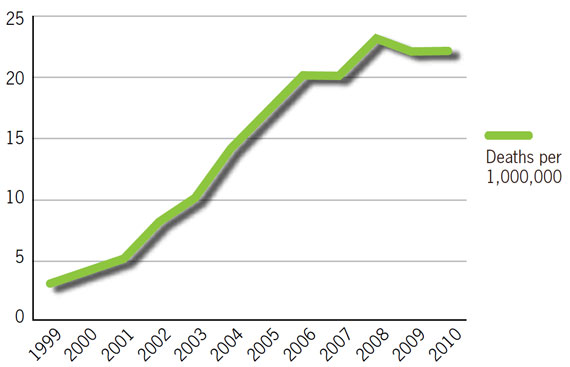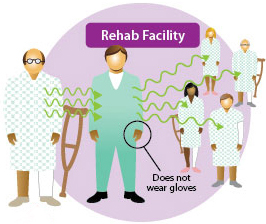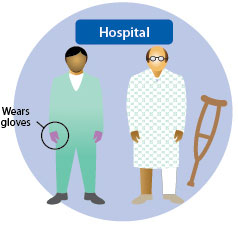Vital Signs: Making Health Care Safer
Stopping C. difficile Infections
March 2012



3x
Hospital stays from C. difficile infections tripled in the last decade, posing a patient safety threat especially harmful to older Americans.

94%
Almost all C. difficile infections are connected to getting medical care.

20%
Hospitals following infection control recommendations lowered C. difficile infection rates by 20% in less than 2 years.
People getting medical care can catch serious infections called health care-associated infections (HAIs). While most types of HAIs are declining, one – caused by the germ C. difficile* – remains at historically high levels. C. difficile causes diarrhea linked to 14,000 American deaths each year. Those most at risk are people, especially older adults, who take antibiotics and also get medical care. When a person takes antibiotics, good germs that protect against infection are destroyed for several months. During this time, patients can get sick from C. difficile picked up from contaminated surfaces or spread from a health care provider’s hands. About 25% of C. difficile infections first show symptoms in hospital patients; 75% first show in nursing home patients or in people recently cared for in doctors’ offices and clinics. C. difficile infections cost at least $1 billion in extra health care costs annually.
*Clostridium difficile (klah-STRID-ee-um DIFF-i-seel)
C. difficile infections are at an all-time high.
- C. difficile infections are linked to 14,000 deaths in the US each year.
- Deaths related to C. difficile increased 400% between 2000 and 2007, due in part to a stronger germ strain.
- Most C. difficile infections are connected with receiving medical care.
- Almost half of infections occur in people younger than 65, but more than 90% of deaths occur in people 65 and older.
- Infection risk generally increases with age; children are at lower risk.
- About 25% of C. difficile infections first show symptoms in hospital patients; 75% first show in nursing home patients or in people recently cared for in doctors’ offices and clinics.
C. difficile germs move with patients from one health care facility to another, infecting other patients.
- Half of all hospital patients with C. difficile infections have the infection when admitted and may spread it within the facility.
- The most dangerous source of spread to others is patients with diarrhea.
- Unnecessary antibiotic use in patients at one facility may increase the spread of C. difficile in another facility when patients transfer.
- When a patient transfers, health care providers are not always told that the patient has or recently had a C. difficile infection, so they may not take the right actions to prevent spread.
C. difficile infections can be prevented.
- Early results from hospital prevention projects show 20% fewer C. difficile infections in less than 2 years with infection prevention and control measures.
- England decreased C. difficile infection rates in hospitals by more than half in 3 years by using infection control recommendations and more careful antibiotic use.
For Clinicians: 6 Steps to Prevention
1. Prescribe and use antibiotics carefully. About 50% of all antibiotics given are not needed, unnecessarily raising the risk of C. difficile infections.
2. Test for C. difficile when patients have diarrhea while on antibiotics or within several months of taking them.
3. Isolate patients with C. difficile immediately.
4. Wear gloves and gowns when treating patients with C. difficile, even during short visits. Hand sanitizer does not kill C. difficile, and hand washing may not be sufficient.
5. Clean room surfaces with bleach or another EPA-approved, spore-killing disinfectant after a patient with C. difficile has been treated there.
6. When a patient transfers, notify the new facility if the patient has a C. difficile infection.
Source: CDC, 2012
Deaths Caused by C. difficile Infections*

* Age-adjusted Rate of C. difficile as the Primary (Underlying) Cause of Death.
Source: CDC National Center for Health Statistics, 2012
How C. difficile Spreads

George, a 68-year-old man, goes to the doctor’s office and is diagnosed with pneumonia. He is prescribed antibiotics, drugs that put him at risk for C.difficile infection for several months.

One Month Later
George breaks his leg and goes to a hospital. A health care worker spreads C.difficile to him after forgetting to wear gloves when treating a C.difficile infected patient in the next room.

Two Days Later
George transfers to a rehabilitation facility for his leg and gets diarrhea. He is not tested for C.difficile. The health care worker doesn’t wear gloves and infects other patients.

Three Days Later
George goes back to the hospital for treatment of diarrhea and tests positive for C.difficile. He is started on specific antibiotics to treat it. Health care workers wear gloves and do not spread C. difficile. George recovers.
Source: CDC, 2012
Federal Government Is
- Tracking and reporting national progress toward preventing C. difficile infections in many types of health care facilities. These programs help track the size of the problem, antibiotics used, and people at risk.
- Promoting C. difficile prevention programs and providing gold-standard patient safety recommendations.
- Providing prevention expertise, as well as outbreak and laboratory support to health departments and facilities.
States and Communities Can
- Encourage health care facilities to track and share data using CDC’s National Healthcare Safety Network.
- Develop regional C. difficile prevention projects with many types of facilities.
- Help health care facilities in their prevention efforts.
- Provide a standardized form for facilities to use during patient transfers, especially between hospitals and nursing homes.
Patients Can
- Take antibiotics only as prescribed by your doctor. Antibiotics can be lifesaving medicines.
- Tell your doctor if you have been on antibiotics and get diarrhea within a few months.
- Wash your hands after using the bathroom.
- Try to use a separate bathroom if you have diarrhea, or be sure the bathroom is cleaned well if someone with diarrhea has used it.
Health Care Facility Administrators Can
- Support better testing, tracking, and reporting of infections and prevention efforts.
- Make sure cleaning staff follows CDC recommendations, using an EPA-approved, spore-killing disinfectant in rooms where C. difficile patients are treated.
- Notify other health care facilities about infectious diseases when patients transfer, especially between hospitals and nursing homes.
- Participate in a regional C. difficile prevention effort.
Doctors and Nurses Can
- Prescribe antibiotics carefully. Once culture results are available, check whether the prescribed antibiotics are correct and necessary.
- Order a C. difficile test (preferably a nucleic acid test) if the patient has had 3 or more unformed stools within 24 hours.
- Be aware of infection rates in your facility or practice, and follow infection control recommendations with every patient. This includes isolating patients who test positive for C. difficile infection and wearing gloves and gowns to treat them.
- CDC Vital Signs Report: Stop C. difficile Infections
- CDC MMWR on C. difficile infections
-
CDC’s C. difficile website
- Infection control recommendations
- Environmental cleaning toolkit and checklist
- C. difficile infection prevention toolkit
- SHEA-IDSA Clinical Practice Guidelines
- For healthcare providers: FAQs about C. difficile
On Other Web Sites
